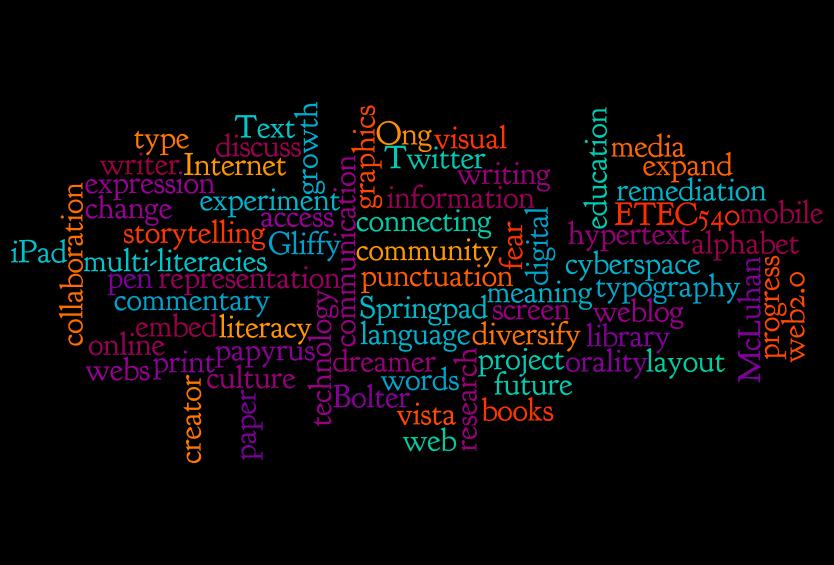Throughout the course my focus has been upon the impact that the evolution of text has had upon my work, my world, and myself. In looking at the development within the realm of text, however, I have not simply gathered information about how text has changed, but have gained tools to evaluate what these tools might do.
Early on in the course I, like others, struggled to see how the information might connect to my educational practice or to the use of technology. Once I began to consider writing itself as a technology, however, the connections began to appear. Whether it was realizing that the stylus I use with my iPad is designed to look like a pen or that my students’ online discussions are dynamic because the tools they use allow them to be, my thinking shifted to understanding that text becoming hypertext has done more than change the medium of writing. Although I gained many useful tools for bringing these changes to my classroom, more importantly I gained means to consider whether or not it is in my students’ best interest to do so. Yes, the number of tools available to educators is growing daily, but there needs to be conversation about why they ought to be used (or not used, in some cases), rather than simply remediation. The fact that an approach or tool is new is not enough to make it worthwhile.
The wordle above is my way of connecting the text from the course that was most significant to me. Although they are isolated words and terms, the ways in which they combine to create a single text is, to me, very representative of the course as a whole. We began with fragmented ideas and conversations about isolated aspects of text, yet now we are discussing interactions, meaning making, and the best tools to enhance our use of text.
The works of Bolter and Ong definitely stood out as key contributors throughout the course, though through the filter of our discussions, without which I do not feel as though the meaning gained would be as significant. Without thought behind and within it, text is much more limited in its ability to empower. Once that text becomes ‘active’, through hypertext, conversation, an engaged reader, or the intent to learn, it becomes powerful. Given this, the most significant text of all throughout this course has been the dynamic and ever evolving text of the course discussions. Although this text did not exist at the outset of the course, it was the most significant and valuable for me on a daily basis. The active nature of our common text created something that was always reflective of our thoughts, questions, and interests and within which we could expand the other texts into something much more.
In other words, the most valuable connections within this course have been the ones between the learners. Whether it was the link between two individuals or the connection one person felt with a certain text, these dynamic links were the ones that brought significance to the experience and the information.
Thanks for a great semester!
-Meggan



Hey Megan!
I really like the wordle that you created! It is a great way to show all of the topics and connections that we have made this term!
I really like what you said in your post above
“Once I began to consider writing itself as a technology, however, the connections began to appear. Whether it was realizing that the stylus I use with my iPad is designed to look like a pen or that my students’ online discussions are dynamic because the tools they use allow them to be, my thinking shifted to understanding that text becoming hypertext has done more than change the medium of writing. ”
I think I also had to change my thinking to consider writing to be a technology. Once I had done this it also helped me to understand better the connections between my everyday teaching and the materials in this course.
~Julie
Megan, your wordle looks great! I like what you have to say about text becoming active when a reader interacts with it. I also like the inclusion of conversation as a type of text…I often focus solely on what can be seen and I forget that audio is also a form of text.